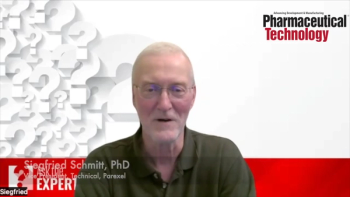
- BioPharm International, May 2024
- Volume 37
- Issue 5
- Pages: 34
Good Manufacturing Practices for Emerging Therapies
Guidance documents and interaction with FDA can help manufacturers stay in GMP compliance, says Siegfried Schmitt, VP Technical, at Parexel.
Q: We read in an article (1) that there are no specific good manufacturing practice (GMP) regulations for emerging therapies in the United States, yet we wish to bring our emerging therapy products to the US market. How can we make sure our products comply with current regulations?
A: In the absence of specific regulations for your products, the existing generic regulations, such as 21 Code of Federal Regulations (CFR), 600 Biological Products (2), will apply as appropriate. Also, international harmonized guidelines, such as International Council for Harmonisation (ICH) Q9(R1) Quality Risk Management and ICH Q10 Pharmaceutical Quality System (3,4) need to be followed and complied with. However, these are not the only sources of regulatory information available. FDA has published guidance on cellular and gene therapy products (5), which includes guidance and information on “Regenerative Medicine Advanced Therapy Designation” and on “Interactions with Office of Tissues and Advanced Therapies”.
Companies, especially developers of new types of drugs, are encouraged to interact with the regulatory authorities early on in the drug development cycle, and FDA is no exception. There are multiple opportunities for formal as well as informal meetings with FDA, and FDA’s website provides an excellent overview, including links to further information (6).
There is more information out there, free of charge, and most likely relevant to the products your company is currently developing. Though international regulations are only harmonized to some degree, there is generally a broad consensus on the basic principles of GMP, be it for traditional drug products or novel, emerging therapy products. Therefore, companies should look at regulations from other regions (e.g., the European Union [EU]) and guidance from key agencies, such as the European Medicines Agency (EMA). The EU have issued specific regulations for advanced therapy medicinal products (7), recognizing the need to address compliance for these products separately. The GMP requirements detailed in here will broadly be the same that FDA expects. Aspects that require further guidance and clarification are often covered in “Questions & Answers” documents published by EMA. An EMA Q&A document published in 2011 (8) discusses, for example, how to identify the minimum GMP requirements for starting materials, considering quality management, quality risk management, product development, production, and quality control.
These are just a few pieces of information in response to your question. There is much more information available online, from specialist publications, subject matter experts, and not least directly from the regulatory agencies through their consultation mechanisms.
References
- Thomas, F. Optimizing the Manufacture of Emerging Therapies. BioPharm Intern. 2023, 36 (5) 24–27.
- US CFR Title 21,
https://www.accessdata.fda.gov/ - ICH. Q9(R1) Quality Risk Management (ICH, Jan. 18, 2023),
www.ich.org . - ICH. Q10 Pharmaceutical Quality System (ICH, June 4, 2008).
- FDA. Cellular & Gene Therapy Products.
FDA.gov (accessed April 4, 2024). - FDA. Interactions with Office of Therapeutic Products.
FDA.gov (accessed April 4, 2024). - EC. Part IV, GMP requirements for Advanced Therapy Medicinal Products.
EudraLex, Volume 4. - EMA.
Questions and Answers on the Principles of GMP for the Manufacturing of Starting Materials of Biological Origin Used to Transfer Genetic Material for the Manufacturing of ATMPs, EMA/246400/2021 Feb. 24, 2021.
Article details
BioPharm International®
Vol. 37, No. 5
May 2024
Page: 34
Citation
When referring to this article, please cite it as Schmitt, S. GMPs for Emerging Therapies. BioPharm International® 2024 37 (5).
Articles in this issue
over 1 year ago
Looking to the Future of Biologicsover 1 year ago
Shoring Up Data Integrity Practicesover 1 year ago
Polysorbates: Part(icle) of the Problem?over 1 year ago
Tapping into the Potential of BiologicsNewsletter
Stay at the forefront of biopharmaceutical innovation—subscribe to BioPharm International for expert insights on drug development, manufacturing, compliance, and more.





